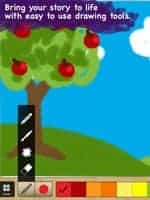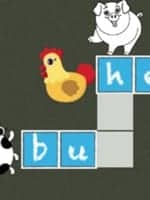10 Ways to Spot a Great Video Game by Jeff Piontek

What your kids look for in a snack might be different than what you look for as a parent. While they focus on taste, you focus on nutrition. Same goes for games. Glitzy, big-name games can be enticing, just like junk food. Some are flashy and addictive but do little to feed kids’ curiosity or help them develop.
But truly great video games can help your kids grow in ways you never thought possible — just like delicious, healthful food. So how can you avoid the sugar-cereal equivalents in the game world? Read these 10 tips to find out.
Great video games:
Draw your kids in. Great games transport kids to another place. You know the signs. Brows furrowed. Thumbs zooming. Yes, you may have to set limits for games that suck time at the expense of other activities. But it’s a good sign when games put kids in a state of “flow.” Games that draw kids in require concentration or imagination and present challenges just beyond their comfort zone. Plus, they’re fun. For example:
- Super Scribblenauts (age 10+) lets kids’ imaginations run wild as they solve puzzles by writing new objects into a scene. Any word they spell is transformed into a digital creation that then appears within the game world.
- Professor Layton and the Last Specter (age 12+) is a fascinating mystery that unfolds piece by piece. Kids learn critical thinking and puzzle-solving skills as they complete a wide variety of brainteasers.
Put kids in the driver’s seat. Having choices can make kids feel powerful. Kids who get to decide which path to take or how to spend their virtual money often feel responsible for their fate in a game. In turn, they feel motivated. Games with lots of choices and opportunities for exploration can help kids feel ownership over the experience. For example:
- ItzaZoo (age 4-7) is a magical experience in which kids see their own art come alive as part of the storyline. Kids can learn skills for reading comprehension and problem solving as they add free-form artwork to colorful, kid-themed landscapes.
- Gamestar Mechanic (age 8+) provides kids with the digital tools they need to create their own video games. While the limited design software keeps kids’ creations pretty basic, the games they make are real and playable. Kids get to feel true ownership over their work.
Suit your child’s age and interest. Some games are so easy to beat that kids quickly lose interest. Others are so difficult that kids get frustrated. Use your kid’s interests and hobbies as a jumping-off point for selecting games. For example:
- Art Academy (age 8+) feels like what you’d expect from a beginners’ course at a real-world art school. Kids can pick up in-depth knowledge and expert tips about shading, perspective, color mixing, and more through 10 incredibly detailed lessons.
- Learn Chess (age 8+) is instructional chess software that covers pretty much every teachable aspect. Kids need a lot of patience and a long attention span, but they can learn a lot if they do. Two players can compete against one another wirelessly, too.
Challenge kids to experiment. The beauty of most games is that you can try again. And again. And again. Running out of time or lives isn’t so bad when you know you have another chance. A willingness to try out several options — and even fail sometimes — is a skill that will serve kids well down the line. For example:
- I Spy Castle (age 6-10) has seek-and-find puzzles that can be real stumpers. Faced with all types of challenging hidden-object puzzles, kids find patterns and create paths — sharpening their observation skills and practicing logical thinking.
- LEGO Harry Potter: Years 5-7 (age 10+) challenges kids to work out the rules of new systems in order to survive. Kids who enter this magical world must use a keen sense of observation and logic to figure their way out of the story-based predicaments.
Let kids create. Imagine kids designing new levels for existing games. Picture creator communities in which kids comment constructively and provide feedback. Many games offer media creation as a key part of the experience. Opportunities to make something new within a game signal to kids that their original work has value. For example:
- LittleBigPlanet (age 8+) lets kids design their own zany platform puzzles as they explore eight wonderful worlds full of Rube-Goldberg-type contraptions and scenery. Its community celebrates invention as players share the levels they’ve crafted with others.
- Minecraft (age 13+) is a refreshingly open-ended mining and construction game that encourages kids to build imaginative block structures. Kids can learn creative thinking, geometry, and a bit of geology as they sculpt creations in this 3-D space.
Add a social element. There’s nothing wrong with a game of solitaire. But as kids get older, games in which the characters (or even real people) socialize and work together can help kids flourish. Skills like teamwork and communication are the cornerstone of today’s workforce. And having social outlets online can help prep kids for the future. For example:
- Herotopia (age 7-10) allows kids to become superheroes who work together to outfox bullies. They can also learn geography and practice good global citizenship, earning points for doing good deeds.
- Skylanders Spyro’s Adventure (age 10+) makes partner problem-solving fun. Kids can investigate problems and figure out solutions, either alone or as a team. They observe clues that may be useful later in the game and figure out how items work together to be helpful.
Complement school. Some kids view video games as an escape from school. Maybe they have trouble sitting still in class but can focus on a video game. Or perhaps a game’s material and format feel more relevant to their lives. Whatever the reason, video games can help teach work and life skills. For example:
- Dora’s Cooking Club (age 4-7) helps kids see math in cooking. They can learn arithmetic basics as they help Dora and her family in put together a series of recipes.
- My Amusement Park (DS) (age 6-10) puts kids in the role of a business owner. They learn how to budget money while building and running their own virtual theme park.
“Tell” instead of “show.” Playing great games is like being sucked into a book that you can’t put down. A distressed prince needs rescue. The world is coming to an end. Try to avoid games that spoon-feed answers to kids through quizzing alone or rote memorization and seek out ones with strong storylines. For example:
- Botanicula (age 10+) begins with tiny creatures that encounter a spider-like monster intent on gobbling up their big, beautiful tree home. The five heroic creatures band together to journey up and down the tree, foiling its parasitic invaders.
- Sid Meier’s Civilization V (age 11+) helps kids gain lasting knowledge about world history by playing the role of an empowered ruler. Players learn about significant developments in human history and how they led to even greater discoveries.
Have style. Looks aren’t everything, of course. But games with a strong and unified look and feel are really appealing. It’s not just that these games are beautiful — it’s that their style serves a higher purpose of drawing players into a unique world. For example:
- Flower (age 7+) lets players control flower petals floating on a breeze as they travel over and restore color to grey fields. The experience of hovering over the countryside surrounded by flickering dabs of color is truly unique.
- Journey (age 10+) presents an unstructured experience of beauty and originality. Players start in the middle of a desert filled with majestic, sand-covered ruins. They slide over dunes and float on both wind and magical energy.
Go beyond repetition. Games in which kids just go through the same motions over and over are okay in moderation. But more variety is nicer. Consider games that mix elements of strategy, action, adventure, role-playing, building, and more. For example:
- Boom Blox (age 7+) offers nearly 400 levels of puzzles, with the object of destroying block structures. Each puzzle can be played over and over again, so that kids can try different ways to solve it.
- Portal 2 (age 10+) presents problems for kids to solve through a process of investigation and prediction. To do so, kids must apply real-world understanding to physics-based conundrums.




























